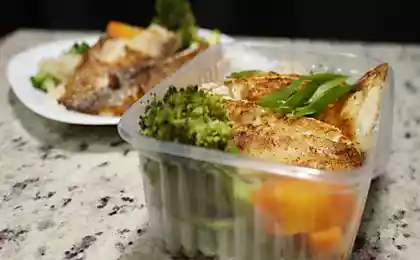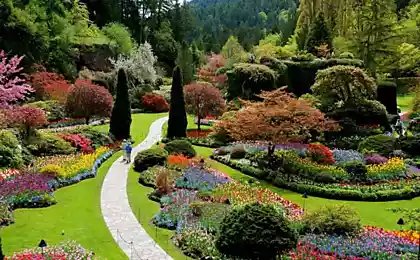190
Polish cottage and garden
It is always interesting to know how in other countries people organize their leisure time and space for it. Take Poland, for example. No matter what politicians say on both sides, Poles are mentally quite similar to us, and living under the incessant eye of officials of the Russian Empire, and later of the Soviet Union, has further strengthened certain similar habits.
Of course, the last 25 years have made changes, but one of the main attributes of the Soviet period of giving remained.
They were greatly transformed under the influence of time, turning into small gardens (in Polish garden - ogród) in front of the house or more often behind it. This is because there is very little free land in Europe. It would be more correct to say that there is no land that does not have an owner. It costs many times more than in Russia, and the tax on real estate and land does not allow people with below average income to maintain such luxury.
However, even in Warsaw – on the right side of the Vistula – you can see the real suburban areas. True, they are not 6 acres like ours, but 3-4. But every year more and more Poles devote all their creative energy to small gardens near the house.
Naturally, you need to understand that such a small space is observed in cities - in neighborhoods with cottage-type buildings. Having left the capital or a large city, in the countryside we will already see 10 and 20 acres around the house. These are farmers' homes -- they have big tax privileges.
In Poland, the spirit of individualism is strong. This is emphasized in everything. Therefore, by organizing the space for their garden, they try to make it different from others.
That's not very difficult to do here. In specialized stores-warehouses, a large number of high-quality seedlings of various types and types are sold. More often, such outlets are located on exits from cities in equipped places with good access for cars, and during planting in the ground, seedlings are sold even along roads from vans by farmers themselves. However, when choosing trees, Poles are a little conservative.
In Polish gardens you will rarely see fruit trees. Mainly planted decorative: tuya (holds primacy, it can be found in most gardens in Poland, where most often it acts as a hedge), juniper, barberry, mulberry and spruce. In the older gardens, planted in 50-60 years, you can find lilacs, kalina and rose hips.
The climate here is not much different from the central regions of Russia. There are many seedlings grown in Poland on the Russian market, but they are specially regionalized for our regions (except in the north).
Another mandatory attribute of the Polish garden is the lawn. Let one or two square meters of lawn, but it is. If space allows, the place under the table is laid out with tiles. And flowers! In standing and hanging containers, round, oval and square, on platforms and on fences ... Kashpo and vases can be bought in different shapes and sizes for any space.
On balconies and galleries, petunia and pelargonia are more often planted. Near the paths or walls you can see all sorts of hosts, velvets, cornflowers and basil.
Of course, Poland is a heterogeneous country and its regions differ from each other. All this is true for central Poland, and in each area, in addition to the main and most popular plants, there is something unique. Let’s not forget about fashion – so, this year the focus was basil, which was planted in parks, and polyanthic roses. But from April to October, the whole of Poland turns into a flowering greenhouse, and every year more flowers bloom here.
P.S. And remember, just changing our consumption – together we change the world!
Join us on Facebook, VKontakte, Odnoklassniki
Source: www.7dach.ru
Of course, the last 25 years have made changes, but one of the main attributes of the Soviet period of giving remained.
They were greatly transformed under the influence of time, turning into small gardens (in Polish garden - ogród) in front of the house or more often behind it. This is because there is very little free land in Europe. It would be more correct to say that there is no land that does not have an owner. It costs many times more than in Russia, and the tax on real estate and land does not allow people with below average income to maintain such luxury.
However, even in Warsaw – on the right side of the Vistula – you can see the real suburban areas. True, they are not 6 acres like ours, but 3-4. But every year more and more Poles devote all their creative energy to small gardens near the house.
Naturally, you need to understand that such a small space is observed in cities - in neighborhoods with cottage-type buildings. Having left the capital or a large city, in the countryside we will already see 10 and 20 acres around the house. These are farmers' homes -- they have big tax privileges.
In Poland, the spirit of individualism is strong. This is emphasized in everything. Therefore, by organizing the space for their garden, they try to make it different from others.
That's not very difficult to do here. In specialized stores-warehouses, a large number of high-quality seedlings of various types and types are sold. More often, such outlets are located on exits from cities in equipped places with good access for cars, and during planting in the ground, seedlings are sold even along roads from vans by farmers themselves. However, when choosing trees, Poles are a little conservative.
In Polish gardens you will rarely see fruit trees. Mainly planted decorative: tuya (holds primacy, it can be found in most gardens in Poland, where most often it acts as a hedge), juniper, barberry, mulberry and spruce. In the older gardens, planted in 50-60 years, you can find lilacs, kalina and rose hips.
The climate here is not much different from the central regions of Russia. There are many seedlings grown in Poland on the Russian market, but they are specially regionalized for our regions (except in the north).
Another mandatory attribute of the Polish garden is the lawn. Let one or two square meters of lawn, but it is. If space allows, the place under the table is laid out with tiles. And flowers! In standing and hanging containers, round, oval and square, on platforms and on fences ... Kashpo and vases can be bought in different shapes and sizes for any space.
On balconies and galleries, petunia and pelargonia are more often planted. Near the paths or walls you can see all sorts of hosts, velvets, cornflowers and basil.
Of course, Poland is a heterogeneous country and its regions differ from each other. All this is true for central Poland, and in each area, in addition to the main and most popular plants, there is something unique. Let’s not forget about fashion – so, this year the focus was basil, which was planted in parks, and polyanthic roses. But from April to October, the whole of Poland turns into a flowering greenhouse, and every year more flowers bloom here.
P.S. And remember, just changing our consumption – together we change the world!
Join us on Facebook, VKontakte, Odnoklassniki
Source: www.7dach.ru























